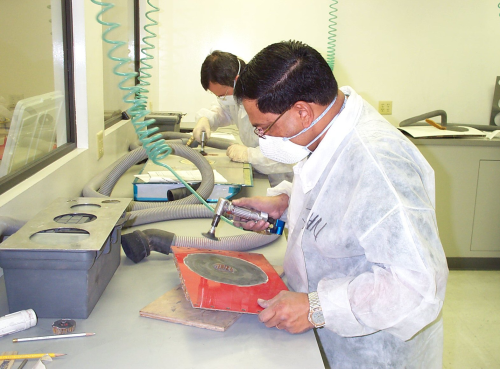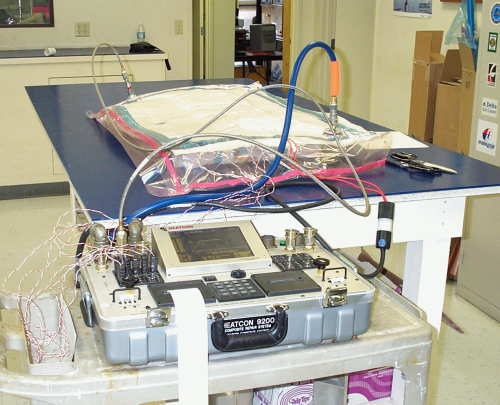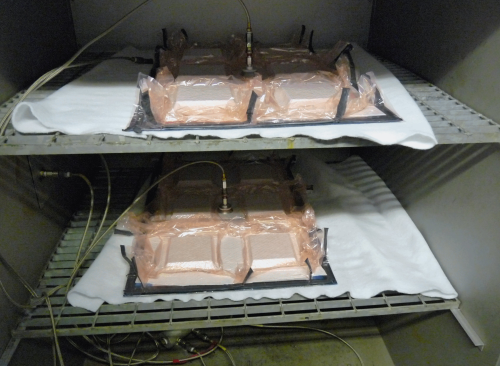


The question of how to repair the latest half reinforced-plastic commercial airliners – notably the Boeing 787 Dreamliner and Airbus A350 XWB – when they are damaged has been thrown into sharp relief by a fire that occurred in July on an Ethiopian Airlines B787 whilst on the ground at London Heathrow Airport (see Heathrow fire: Ethiopia Dreamliner fleet to stay flying).
This fire, apparently caused by a faulty Emergency Locator Transmitter (ELT), seriously damaged the composite fuselage towards the tail and requires a major repair that is well outside the scope of the manufacturer’s Structural Repair Manual (SRM).
Boeing, faced for the first time with this extensive damage to a tape-wound composite fuselage, is now considering how to undertake this repair – once the legal arguments regarding liability for the costs have been settled. The nature and magnitude of the task take the airframer into new territory and Boeing will have to learn by experience in actually doing the job. This also happens to be the best way, albeit on a smaller scale and on a personal level, that repair technicians around the world can learn how to repair the latest generation of largely composite aircraft.
Hence hands-on practice should be a key element of technician training. Admittedly, course participants are not stepping into the unknown to the same extent since they learn under close guidance from instructors who have relevant expertise. Even so, they will be embarking on a journey of discovery that is not just personal but involves the entire aircraft maintenance, repair and overhaul (MRO) industry. Indeed, today’s students will soon find themselves helping to develop tomorrow’s repair solutions for the new generation of extensively composite aerostructures.
Practical experience
Hands-on emphasis is certainly clear at UK-based Aeroskills International Ltd whose courses are as much as 80% practical and workshop focused. This modestly sized company has provided training in composite aerostructure repairs since 1992, making use of fully equipped workshops at the University of Hertfordshire and workshops of similar standard around the world.
Aeroskills training, based on repair methods specified by aircraft manufacturers, gives students hand-on experience of repairs with a wide variety of materials, including glass, carbon and aramid fabrics and prepregs, epoxy resins and Nomex and aluminium honeycombs. Customers include major airlines, maintenance companies and air force maintenance departments. Instruction is not product based and equipment such as tooling, hot bonders and vacuum bagging is sourced from a range of manufacturers.
Each of the company’s Aircraft Composites Repair courses takes 10 working days. After some initial theory, course content is mainly practical, with students actively repairing both monolithic and sandwich structures including curved panels and edge bands. Trainees handle wet lay-up and prepreg materials, and use custom-made tooling. Overall, they gain enough practical experience to enable them to tackle most common types of damage to aircraft composite structures.
An organisation that has become a global force in composites education, including repairs, is Abaris Training Resources Inc, a US firm that can boast three decades of experience in this field, with over 1000 trainees per year now experiencing its instruction.
As president Michael Hoke expounds: “All our courses include a great deal of hands-on practice, providing real-world scenarios, on actual composite parts and components. Our students go away with the confidence and knowledge to conduct top-quality repairs in a timely manner.”
R is for repair
Abaris offers 18 courses for hand-on technicians and eight suitable for degree-level engineers. Training is available at set locations around the world or at customer sites as required. Technicians with experience of repairing metal aircraft are taught how to repair damaged composite structures in three phases. Each of the three R (for repair) courses takes an intensive five days – a working week.
The first week/phase is a foundation course that is half theory, imparting basic composites knowledge, and half practical. The second five-day phase is about 75% practical, students undertaking a repair each day, those repairs increasing in complexity as the week progresses. Students are given composite samples that present different repair challenges, material usage and processes. During the exercises, they experience various types of hot bonder, learn the finer points of heat blanket and thermocouple placement, and engage with multiple bagging schedules and bleeder/breather scenarios.
In Phase 3, which is as much as 90% practical, students undertake a single major repair over the five working days.
Associated lectures cover such aspects as:
- introduction to repair instructions given in manufacturers’ SRMs;
- understanding of different materials and laminates; and
- site preparation, including excising of damage, paint removal, laminate drying and surface preparation.
Teaching encompasses both scarfed and patch repairs. At the end of the three weeks, technicians are considered competent to tackle any of the routine repairs that are within the scope of the airframer’s SRM.
Other related courses deal with non-destructive testing (NDT), repair of bonded (composite-to-composite and composite-to-metal) structures, mould tool fabrication, repair analysis and substantiation and, as a pinnacle, a ‘train the trainer’ course leading to instructor certification.
| Composite repair skills are not something you can learn at the computer; you might as well ask someone to learn how to ride a bicycle from the Internet. |
| Michael Hoke, president, Abaris Training Resources Inc |
Students have expressed appreciation of the high practical content of Abaris training and in acknowledging this Michael Hoke notes: “It’s important to make sure that composite repair technicians have the hands-on skills required and they can only gain these by practice. We do get requests for on-line courses, but that’s just not realistic. Composite repair skills are not something you can learn at the computer; you might as well ask someone to learn how to ride a bicycle from the Internet.”
Hoke is proud of his company’s ability to train from foundation right through to instructor level. A firm believer in certification, he continues to champion the development of certification routes via the Commercial Aircraft Composite Repair Committee (CACRC), which is pursuing a model already proven through aerospace welding and NDT certification training. ♦
PART 2 of this article will be published on ReinforcedPlastics.com next month.
This article will be published in the November/December 2013 issue of Reinforced Plastics magazine.
The digital edition of Reinforced Plastics is distributed free of charge to readers who meet our qualifying criteria. You can apply to receive your free copy by completing the registration form.
Reinforced Plastics is also available on ScienceDirect, Elsevier's full-text scientific database offering journal articles and book chapters from more than 2,500 journals and almost 20,000 books.





